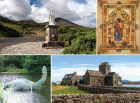Roman Britain
Roman Britain is a familiar topic on the primary curriculum and links chronologically to the Stone Age to Iron Age topic as well as the Saxons and Vikings. The focus is upon invasion, conquest, rebellion and Romanisation.
-

Trade – lifeblood of the empire: how trade affected life in Roman Britain
ArticleClick to view -

Teaching ‘these islands’ from prehistoric times to 1066
ArticleClick to view -

Developing a big picture of the Romans, Anglo-Saxons and Vikings
ArticleClick to view -

Teaching the Romans in Britain: a study focusing on Hadrian’s Wall
ArticleClick to view -

Using apps in the history curriculum
ArticleClick to view -

One of my favourite history places: Chichester's Roman walls
ArticleClick to view -

Ordinary Roman life
ArticleClick to view -

One of my favourite history places: Hadrian's Wall
ArticleClick to view -

What confuses primary children in history...
ArticleClick to view -

Pull-out Posters: Primary History 70
ArticleClick to view -

The Roman Empire and its impact on Britain
ArticleClick to view -

Using the back cover image: Reconstructing the Romans
ArticleClick to view -

TREE-mendous history!
ArticleClick to view -

Developing enjoyable historical investigations
ArticleClick to view -

Place-names and the National Curriculum for History
ArticleClick to view -

Pull-out Posters: Primary History 68
ArticleClick to view -

Britain from the Iron Age to Robin Hood
ArticleClick to view -

The world on the wall: exploring diversity on Hadrian's Wall
ArticleClick to view -

Political literacy: citizenship through the English national curriculum's the Romans in Britain study unit
ArticleClick to view -

Roman Britain
ArticleClick to view

